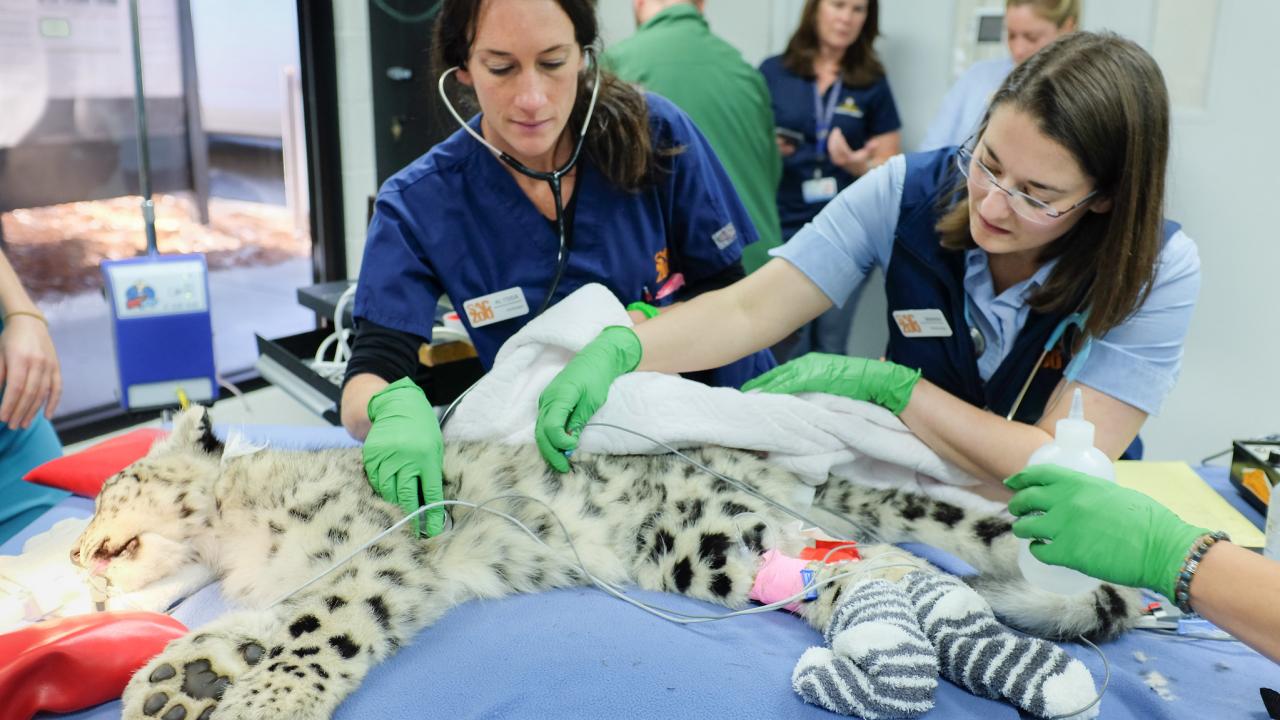
Dr. Jenessa Gjeltema Treats Creatures Great and Small
Featured profile from the College of Charleston Magazine by Tom Cunneff
It’s a drizzly Tuesday in March in Sacramento, Calif., and about a dozen children from a local elementary school have their noses pressed against the viewing windows of the veterinary hospital at the city zoo to view a very rare species on the other side of the glass. Dr. Jenessa Tookey Gjeltema ’04 is doing an annual exam on a red panda, an endangered foxlike creature from the Himalayas named Takeo. But he’s not the really rare one.
She is.
Gjeltema is one of just 215 veterinarians in the world that the American College of Zoological Medicine has certified as an expert, which requires passing a grueling, two-day examination following years of study. As an assistant professor of zoological medicine at nearby University of California, Davis (the top veterinary school in the nation), she does clinical work six months a year at the Sacramento Zoo, providing medical care for the 560 animals, from carnivores such as lions to amphibians like poison dart frogs.
“I love helping individual animals and the art of trying to figure out the appropriate treatments to help them thrive and become healthy,” she says. “But I also really love zoological medicine because I can contribute on a larger scale. By learning about different techniques or diseases that affect zoological species, I can potentially help with conservation efforts that may impact populations that are at risk of becoming extinct. It’s not just about helping an individual animal. It’s about helping to save all wildlife.”
For the latter, Gjeltema spends a good bulk of her time in the lab and in the wild doing research, but today she’s focused on working with individual animals at the zoo – and seeing her in action is a unique peek behind the scenes with a top zoological veterinarian. One of the qualities that has made her stand out in her field was her education at the College, which had nothing to do with pre-med or science (an Honors College and cum laude graduate, she was a triple major in philosophy, business administration and international business).
“There’s book smart and there’s street smart,” says the zoo’s hospital manager and senior vet tech Alison Mott. “She’s got it all rolled into one. She’s constantly learning and trying to provide the best possible care for animals in our collection, and she does that really, really well.”
The 14-acre zoo is tucked in between an elementary school and a park just south of downtown. Dressed in a dark blue vest with a “Sac Zoo” logo on it and a radio clipped to her chinos, Gjeltema is as present and pleasant as can be. She loves what she does, and it shows. There’s nothing typical about a typical day – except for the fact that they’re all 12 hours long.
“The good news is that every day is different,” she says. “It’s challenging. It’s exciting. I’m never doing the same thing twice.”
The first stop is the giraffe barn to examine a 20-year-old female named Goody, who has a front foot injury. Although the giraffes seem like gentle giants as they lean over to sniff the new visitors, their stomping can be deadly (just Google “giraffe killing lion”). Oftentimes, the keepers will maneuver the giraffes into a familiar chute where Gjeltema can perform treatments on their hoofs through a trap door near the floor. The chute is also where Gjeltema can sedate them and use straps to help them gently roll out through a side panel and onto the barn floor, where she can then perform procedures. Since the giraffes can’t really duck into the vet clinic, Gjeltema has to bring the hospital to them.
“They’re one of the more challenging animals to anesthetize,” she says, “just because they have such an incredibly different physiology relating to that really long neck.”
The schedule for the rest of her day would overwhelm most mortals, but purpose and joy can be powerful energizers. In addition to the red panda and a two-toed sloth that she will be giving full annual exams – which includes everything from teeth cleaning and blood work to sonograms and radiographs – Gjeltema also has 10 other animals, including a pair of fennec foxes, a gopher snake and a juvenile flamingo, to examine or treat.
